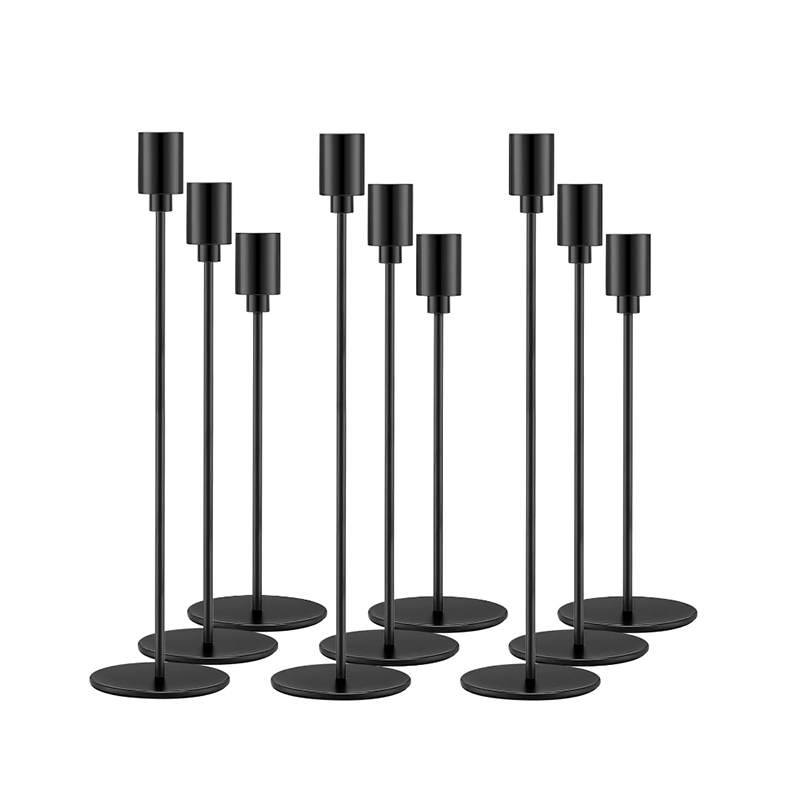How can a candle stick be lightweight and portable while maintaining stability and wind resistance?
It is a complex design challenge for a candle stick to achieve lightness and portability while maintaining stability and wind resistance. This requires comprehensive consideration of multiple aspects such as material selection, structural design, functional optimization, and manufacturing process. The following is a detailed analysis and solution:
1. Material selection
(1) Lightweight and high-strength materials
Use lightweight but strong materials (such as aluminum alloy, titanium alloy, or carbon fiber composites) to reduce the overall weight of the candle stick.
Aluminum alloy: Lightweight and corrosion-resistant, suitable for outdoor use.
Titanium alloy: High strength and lighter, but higher cost, suitable for high-end products.
Carbon fiber composites: Extremely light and rigid, but requires precision processing.
(2) Environmentally friendly materials
Use renewable or bio-based materials (such as bamboo, recycled plastic, or plant fiber composites) to achieve lightweight and environmental goals.
These materials are not only lightweight, but also reduce the impact on the environment.
(3) Windproof coating
Apply a windproof coating (such as nano-coating or hydrophobic coating) to the surface of the candle stick to reduce the impact of wind on the flame and improve stability.
2. Structural design optimization
(1) Low center of gravity design
Ensure that the candle holder remains stable while being lightweight by increasing the weight at the bottom or lowering the overall center of gravity.
A counterweight (such as a metal base or filler) can be added to the bottom while keeping the upper structure light.
(2) Folding and modular design
The foldable or detachable design makes the candle holder smaller when stored and carried, but can be quickly assembled into a stable structure when in use.
The modular design can also adjust the height or expand the function according to needs.
(3) Wide base design
Design a wide base or support foot to increase the contact area and stability.
The base can be hollowed out to provide sufficient support while reducing weight.
(4) Wind shield integration
Integrate a transparent wind shield (such as glass or heat-resistant plastic) on the top or around the candle holder to protect the flame from wind interference.
The wind shield can be designed to be detachable or rotatable for easy cleaning and storage.
3. Functional optimization
(1) Automatic adjustment function
For smart candle holders, sensors can be used to detect wind speed and automatically adjust the flame height or start windproof mode.
For example, using an electronic ignition system and LED to simulate flames is safe and easy to control.
(2) Wax collection design
Design a wax collection tank at the bottom of the candle holder to prevent wax dripping from affecting stability or polluting the environment.
The collection tank can be detachable for easy cleaning and reuse.
(3) Anti-dumping mechanism
Add anti-slip pads (such as silicone or rubber pads) to enhance bottom friction and prevent the candle holder from sliding on smooth surfaces.
Add a tilt sensing device to the design to automatically extinguish the flame or sound an alarm when the candle holder tilts.
4. Manufacturing process
(1) Precision machining
Use CNC machining or 3D printing technology to ensure the precision and structural strength of lightweight design.
Reinforce key components (such as connectors or support rods) to avoid weakening due to weight reduction.
(2) One-piece design
Injection molding or die-casting processes are used to achieve one-piece molding, reducing seams and welding points, thereby reducing weight and improving overall strength.
(3) Surface treatment
Anodize or spray metal parts to enhance corrosion resistance and aesthetics while maintaining lightweight characteristics.
5. Testing and verification
(1) Stability test
Test the anti-tilting performance of the candle holder under different ground conditions (such as smooth floors, carpets or uneven floors).
Ensure that the candle holder can remain stable in various environments after lightweight design.
(2) Wind resistance test
Simulate different wind speed conditions in wind tunnel experiments to evaluate the wind resistance and flame stability of the candle holder.
Optimize the wind shield design or adjust the structural layout based on the test results.
(3) Fatigue test
Simulate long-term use scenarios (such as repeated folding, assembly and disassembly) to evaluate the durability and reliability of the candle holder.
6. User recommendations
(1) Correct use of wind protection function
Guide users to enable wind shields or choose candle holders with wind protection functions when using outdoors.
Provide operating instructions to help users correctly install and use windproof devices.
(2) Choose a site properly
It is recommended that users choose a sheltered area when using outdoors, or place the candle holder near a shelter to reduce the impact of wind.
(3) Regular maintenance
Regularly check the key components of the candle holder (such as wind shields, connectors and bases), and replace worn or loose parts in a timely manner.
In order to achieve lightweight and portability while maintaining stability and wind resistance, the candle holder needs to be comprehensively considered from aspects such as material selection, structural design, functional optimization and manufacturing process. This design problem can be effectively solved by selecting lightweight and high-strength materials, optimizing the center of gravity distribution, integrating windproof functions and strengthening testing and verification. In addition, the correct use and maintenance of the user is also an important factor in ensuring the performance of the candle holder.


 English
English Español
Español












